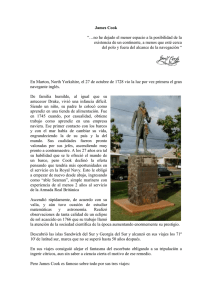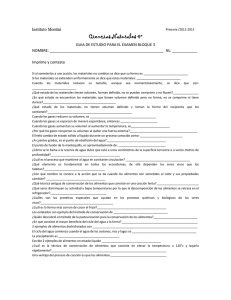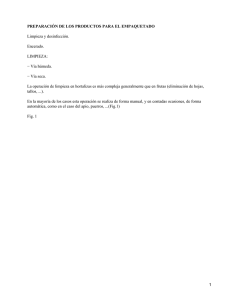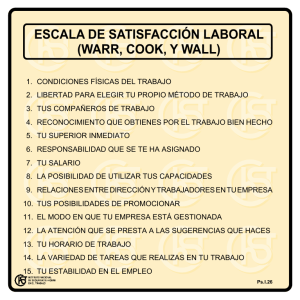980245 MEPAMSA VT
Anuncio
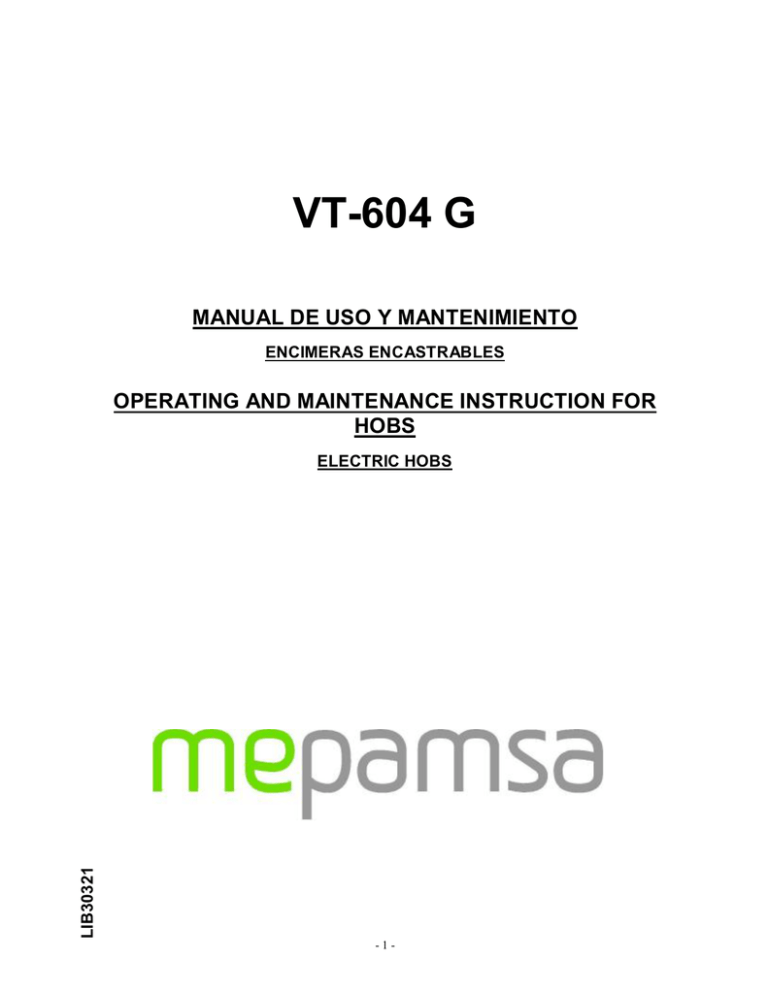
VT-604 G MANUAL DE USO Y MANTENIMIENTO ENCIMERAS ENCASTRABLES OPERATING AND MAINTENANCE INSTRUCTION FOR HOBS LIB30321 ELECTRIC HOBS -1- DATOS TÉCNICOS MODELO Tensión Corriente Placa radiante 1200 W Placa radiante 1700 W Placa radiante 2100 W Placa radiante 2100/650 W Potencia máxima W Cable de alimentación VT-604 G 230V 27 A 2 1 1 / 6200 2 3x2,5 mm 1. Montaje (Fig1) La instalación es a cargo del comprador. El Fabricante no tiene la obligación de efectuar dicho servicio. Los servicios requeridos al Fabricante, si derivaran de una instalación incorrecta, no están incluidos en la garantía. Las placas empotrables están preparadas para ser instaladas en encimeras de cualquier material, siempre y cuando resistan a una temperatura de 100°C, y tengan un grosor entre 25 y 40 mm. La distancia mínima entre una eventual pared vertical de un mueble columna adosado y el borde de la placa debe ser de 150 mm como mínimo; mientras que la distancia entre la pared trasera y el borde de la placa debe ser de 55 mm como mínimo. Si debajo de la placa hay un espacio utilizable, debe aislarse mediante una pared divisoria de material apropiado (madera o similar). Dicha pared debe estar a 25 mm, como mínimo, del fondo de la placa. Fijación al mueble (Fig 2) La fijación al mueble se realiza con soportes de fijación que se entregan como accesorios. En la parte inferior de la placa hay agujeros en donde se introducen las espigas (A) y se enroscan los tornillos (C) que bloquean las grapas de fijación (B). Aplicación de la junta (Fig 3) Importante - La figura de abajo indica el modo de aplicar el sellador en todo el perímetro. Este aparato ha sido fabricado para uso doméstico (no profesional). 2. Conexión eléctrica (Fig 4) Compruebe los datos indicados en la placa situada en el fondo de la encimera y verifique que la tensión nominal de línea y potencia disponibles sean adecuadas para su funcionamiento. Antes de efectuar la conexión, controle la eficiencia de la instalación de toma a tierra obligatoria por Ley. El Fabricante no se asume ninguna responsabilidad por posibles lesiones a personas o daños a cosas causados por la inobservancia de dicha norma. Para los modelos sin enchufe, instale en el cable un enchufe normalizado que soporte la carga indicada en la placa de características. El conductor de tierra del cable es de color amarillo-verde. En todos los casos el enchufe debe ser accesible. Si se desea realizar una conexión fija a la línea, habrá que colocar entre el aparato y la línea, un dispositivo omnipolar de corte con una distancia entre los contactos de 3 mm como mínimo. Para conectar el cable a la encimera hay que aflojar y quitar la tapa de la regleta para llegar a los contactos. Una vez efectuada la conexión, bloquee el cable con el sistema de fijación y cierre la tapa de la regleta. Si hubiera que sustituir el cable de alimentación, el conductor de tierra (amarillo-verde) debe ser, obligatoriamente, 10 mm más largo que los conductores de línea. Use sólo un cable de goma tipo H05RR-F. DECLARACIÓN DE CONFORMIDAD. Las partes destinadas a tener contacto con substancias alimenticias de este aparato son conformes a la Directiva 89/109 CEE y al Dec. Legislativo N° 108 del 25/1/92. CE Aparato conforme a las directivas europeas 89/336/CEE, 93/68/CEE, 73/23/CEE y modificaciones siguientes. Este aparado cumple la Directiva Europea 2002/96/CE sobre Residuos de equipos eléctricos y electrónicos (RAEE). Esta directriz enmarca la validez en toda Europa de la devolución y reciclado de los Residuos de equipos eléctricos y electrónicos. -2- INSTRUCCIONES PARA EL USO Importante: limpiar la encimera antes de cocinar por primera vez. Después, hay que encender todas las placas una a una en vacío, sin ninguna olla apoyada, durante 5 minutos a temperatura máxima. De esta manera se eliminará el olor a nuevo y se evaporará la humedad acumulada en las placas. Esto también es necesario para que los dispositivos electrónicos funcionen perfectamente. ENCIMERA DE VITROCERÁMICA CON MANDOS TÁCTILES (TOUCH CONTROL) 1. 1. 2. 3. 4. 5. 8. Descripción de los mandos (Fig 5) Botón de encendido (ON/OFF) Botón zona cocción (ON/OFF) Display valor configurado (calor residual) Botón “menos” Botón “más” Punto decimal del display de configuración Encendido: la zona de cocción se puede regular Apagado: la zona de cocción está bloqueada Botones táctiles Todas las operaciones se realizan con botones táctiles (sensores capacitivos) situados en la parte frontal de la encimera; a cada botón corresponde un display. 2. Encendido y apagado (Fig 6) Toque el botón de encendido (1) Se activa el control: los indicadores de nivel de regulación (3) muestran “0” y los puntos decimales (8) parpadean. La próxima operación se debe realizar antes de 20 segundos, en caso contrario, el dispositivo se apaga automáticamente. Encender / apagar una zona de cocción. (Fig 7) Con el Touch encendido seleccione la zona de cocción deseada accionando la tecla de selección correspondiente (tecla “+” (5-2) de la respectiva zona). Un punto encendido en el visor (8) de la zona, indica la selección. Si la zona “quema” se visualizará una “H” alternándose con el “0”. En los demás visores (3) el punto de selección que parpadea se apaga. Accionando de nuevo la tecla “+”, se puede seleccionar un nivel de potencia y la zona empezará a calentar. Después de la selección, es necesario no accionar la tecla “+” durante 3 segundos antes de poderla utilizar de nuevo para escoger la potencia. Después de seleccionar la zona de cocción, es posible seleccionar el nivel de potencia pulsando la tecla MÁS, empezando por el nivel 1 se aumenta una unidad cada 0,4 segundos. Cuando se alcanza el nivel 9 no es posible efectuar ulteriores aumentos. Si la zona de cocción se selecciona mediante la tecla central “-” (4), el nivel inicial es el “9” (nivel máximo). Manteniendo pulsada la tecla el nivel activo disminuye una unidad cada 0,4 segundos. Cuando se alcanza el nivel 0 no es posible efectuar ulteriores disminuciones. Sólo es posible modificar la selección accionando de nuevo la tecla “-” (o “+”). Apagar una zona de cocción. Seleccione la zona que quiere apagar con la tecla de selección (“+”). La selección se indica con el punto en el visor de la zona correspondiente. Accionando la tecla “+” y “-” al mismo tiempo, el nivel de potencia de la zona se sitúa en el 0. Como alternativa, la tecla “-” se puede utilizar para disminuir el nivel de potencia hasta 0. Si todas las zonas de cocción se encuentran en el nivel de potencia “0”, los puntos decimales en los visores parpadean. Si una zona de cocción “quema”, aparecerá una “H” en lugar del “0”. Indicador de calor residual (Fig 8) Cuando la zona de cocción está todavía caliente, a tal punto que podría quemar, el display que corresponde a dicha zona muestra el símbolo “H” (calor residual). La indicación desaparece sólo cuando la temperatura ya no es peligrosa (60°C). El display (3) muestra “0” mientras la temperatura permanece por debajo de 60°C y muestra “H” cuando la temperatura supera 60°C. Para ahorrar energía, apague la zona de cocción anticipadamente y aproveche el calor residual. La señal de calor residual “H” se pierde después de un corte de tensión superior a 3 segundos. -3- Apagado de la encimera (Fig 9) La encimera se puede apagar en cualquier momento con el botón de encendido (1). 3. Protección en caso de encendido involuntario. Si el control electrónico detecta que una tecla permanece activa de forma continua durante aproximadamente 10 segundos se apaga de forma automática. El control emite una señal acústica de error durante 10 segundos que advierte al usuario de la presencia de un objeto en los sensores. Los visores muestran el código de error “E R 0 3“ hasta que el control electrónico advierta el error. Si la zona de cocción “quema”, aparecerá una “H“ en el visor que se alternará con el señal de error. Si no se activa ninguna zona de cocción en los siguientes 20 segundos a partir del momento de encendido del Touch, el control vuelve a la modalidad stand-by (reposo). Cuando el control está encendido, la tecla ON/OFF tiene prioridad sobre todas las demás teclas y, como consecuencia, el control se puede apagar en cualquier momento incluso en caso de activación múltiple o continua de teclas. En la modalidad stand-by, una activación continua de teclas no tendrá ningún efecto. De todos modos, antes de que el control electrónico se pueda encender de nuevo, tiene que reconocer que no existe ninguna tecla activada. 4. Bloqueo de las funciones de la encimera El seguro para niños se puede activar después de haber encendido el Touch pulsando de forma simultánea la tecla de selección de la zona inferior derecha (2-5) y la tecla “-“ (4) y luego pulsando de nuevo la tecla de selección de la zona inferior derecha (2-5). Aparecerá una “L” que significa LOCKED (seguro para niños contra el encendido involuntario). Si la zona de cocción “quema” la “L” y la “H” se visualizarán de forma alternativa. Esta operación tiene que efectuarse en los siguientes 10 segundos, no se debe accionar ninguna otra tecla aparte de las que se acaban de mencionar. En caso contrario la secuencia se interrumpe y la placa no se bloqueará. El control electrónico permanece bloqueado hasta que el usuario no lo desbloquea, aunque mientras tanto se haya apagado y vuelto a encender. Cuando se produce un reset del touch (después de una caída de tensión) el bloqueo de las teclas permanece activo. Desbloqueo de las teclas para cocinar Para desbloquear el touch es necesario accionar al mismo tiempo la tecla de selección de la zona de cocción inferior derecha y la tecla “-“. La “L“ (LOCKED/bloqueado) que se encuentra en el visor desaparece y todas las zonas de cocción muestran el “0“ con un punto que parpadea. Si una zona de cocción “quemase”, se visualizaría la “H” en lugar del “0”. Después de haber apagado el touch, el seguro para los niños se activa de nuevo. Eliminación del bloqueo de teclas Después de encender el touch el seguro para los niños se puede desactivar. Es necesario accionar al mismo tiempo la tecla de selección de la zona de cocción inferior derecho y la tecla “-“ y luego accionar la tecla “-“ sola. Si se efectúan todos los pasos en el orden correcto en los siguientes 10 segundos, el bloqueo de las teclas desaparecerá y el touch se apagará. En caso contrario la secuencia se considerará incompleta, el touch permanecerá bloqueado y se apagará cuando hayan pasado 20 segundos. Encendiendo de nuevo el touch con la tecla ON/OFF todos los visores mostrarán el “0”, los puntos decimales parpadearán y el touch estará preparado para la cocción. Si una zona de cocción “quema”, se mostrará la “H” en lugar del “0”. -4- LIMPIEZA Y MANTENIMIENTO Algunos consejos para cocinar Use sólo sartenes y ollas con fondo robusto y, a ser posible, grueso, principalmente para las preparaciones con altas temperaturas de cocción, tales como los fritos. Los fondos que cóncavos prolongan el tiempo de preparación y malgastan energía. La mejor transmisión del calor se obtiene cuando la olla y la zona de cocción tienen las mismas dimensiones. En las zonas de cocción también se puede emplear vidrio Pyrex y porcelana, siempre y cuando el fondo sea liso. Observe las instrucciones suministradas por el fabricante del recipiente. Las salpicaduras se deberán eliminar de inmediato. Notas importantes Atención: las superficies de las zonas de cocción se vuelven incandescentes durante el uso. Por dicho motivo, se aconseja mantener los niños lejos de su alcance. No haga caer objetos duros sobre las superficies de cocción. En algunas condiciones, el material es sensible a las cargas mecánicas. La caída de objetos con punta podría romper la superficie de cocción. Si la superficie de cerámica se rompiera, agrietara o rayara inadvertidamente, deje de usar de inmediato la encimera y contacte al servicio de asistencia cliente. La superficie de vitrocerámica no debe ser usada como superficie de apoyo. No utilizar olla en aluminio No preparar comidas envueltas en hojas de aluminio o en materiales plásticos. No accione jamás las placas sin ollas. No coloque objetos inflamables, explosivos o deformables en proximidad de la zona de cocción. Las grasas o aceites recalentados pueden inflamarse; por dicho motivo, las comidas que prevean el uso de grasas o aceites, tales como patatas fritas, deben controlarse durante la cocción. Además, es necesario asegurarse de que los cables y los enchufes de otros electrodomésticos nunca tengan contacto con las superficies de cocción calientes. El cable, en ningún punto tendrá que llegar a una temperatura superior de 50°C a la temperatura ambiente. Si el cable de alimentación está dañado, debe ser substituido por un cable o conjunto especial a suministrar por el fabricante o servicio postventa. Si la superficie se rompe, desconectar inmediatamente el aparato de la red para evitar la posibilidad de sufrir un choque eléctrico No limpie jamás su encimera con equipos de limpieza a vapor o similares. Después de cada uso hay que limpiar la encimera, tras dejarla enfriar. Hasta los residuos más pequeños se carbonizarán cuando se utilice nuevamente la encimera. Use sólo detergentes específicos. La esponja de acero, las esponjas abrasivas y los polvos pueden rayar el producto. No utilice productos de limpieza para horno porque son corrosivos. La suciedad ligera se puede eliminar con un paño húmedo o con sosa caliente. Los residuos de detergente se deben eliminar con agua fría y luego secar perfectamente. Las manchas resistentes al agua hirviendo se pueden eliminar con vinagre y limón, o con líquidos antical. Si uno de dichos detergentes tuviera contacto con el marco, límpielo de inmediato con un paño mojado para que no se deteriore. Las incrustaciones se pueden eliminar fácilmente con una rasqueta para vidrio. El mango de la rasqueta no debe ser de plástico porque se podría pegar a las superficies calientes. Tenga mucho cuidado durante su uso: peligro de heridas. El azúcar y los alimentos con azúcar acaramelada se deben eliminar de inmediato de las zonas de cocción encendidas. Este electrodomestico está marcado conforme a la directiva Europea 2002/96/CE sobre los residuos de aparatos eléctricos y electrónicos (WEEE). Asegurándose que este producto ha sido eliminado correctamente, ayudará a evitar posibles consecuencias negativas en el ambiente y la salud de las personas, que pudiera verificarse por causa de un anómalo tratamiento de este producto El simbolo sobre el producto indica que este aparato no puede ser tratado como un residuo doméstico normal, en su ligar deberá ser entregado al centro de recogidas para reciclaje de aparatos eléctricos y electrónicos. La eliminación debe ser efectuada de acuerdo con las reglas medioambientales vigentes para el tratamiento de los residuos. Para informacion más detallada sobre el tratamiento, recuperación y reciclaje de este producto, por favor contacte con la oficina compentente (del departamento de ecología y mediomabiente), o su servicio de recogida a domicilio si lo hubiera o el punto de venta donde compró el producto. -5- SERVICIO DE ASISTENCIA TÉCNICA Antes de llamar al Servicio de Asistencia Técnica: Si la encimera no funcionara, le aconsejamos controlar que el enchufe esté bien conectado. Si no se logra detectar el problema: apague el aparato, no trate de repararlo y llame al Servicio de Asistencia Técnica. El aparato está amparado por garantía que le permite aprovechar el Servicio de Asistencia Técnica. Conserve la factura o recibo de compra para testificar la fecha de la misma. En caso de necesidad, tendrá que mostrar al Servicio de Asistencia Técnica este documento fiscal emitido por el revendedor en el momento de la compra (documento de entrega, factura, recibo fiscal, etc.) en el que están indicados el nombre del revendedor, la fecha de entrega, los datos del producto y el precio de venta. -6- TECHNICAL DATA MODEL Voltage Current Radaiant plate 1200W Radaiant plate 1700W Radaiant plate 2100W Radaiant plate 2100/650W Max power W Electrical cable VT-604 G 230V 27 A 2 1 1 / 6200 2 3x2,5 mm 1.Installation (Fig 1) Installation is the buyer’s responsibility. The manufacturer accepts no liability for this service. Any action that the manufacturer has to take due to an erroneous installation will not be covered by the guarantee. The flush-mounted cook tops are designed for installation in work tops made of all kinds of material, providing they can withstand a temperature of 100°C, and are between 25 and 40 mm thick. If the cook top is installed in a position so that the side of a kitchen unit comes up against its left-hand or right-hand side, the distance between the vertical panel and the edge of the cook top must always be at least 150 mm. The distance between the back wall and the edge of the cook top must be at least 55 mm. A partition made of insulating material (wood or the like) must be inserted between the cook top and the space below. This partition must be at least 25 mm from the underside of the cook top tray. Fixing the cook top to the unit (Fig 2) The cook top is fixed to the unit by means of the brackets and accessories provided. Holes are provided in the bottom of the tray where the tabs (A) are inserted so that you can attach the screws (C) that hold the brackets (B) in place. Applying the seal (Fig 3) Important - The figure shows how the seal must be attached all around the perimeter. This cook top has been designed for non-professional, domestic use. 2.Electric connections (Fig 4) Check the details given on the nameplate situated on the underside of the cook top, then make sure that the rated mains voltage and power available are suitable for its operation. Before making the electric connections, check the efficiency of the earthing system. Earthing of the cook top is compulsory by law. The manufacturer will accept no liability for any personal injury or damage to property deriving from failure to comply with this requirement. For models without a plug, fit a standard plug capable of withstanding the specified load on the power cord. The cord’s earthing conductor is colored yellow and green. The plug must be accessible. If you prefer to make a fixed connection to the mains, insert an all-pole circuit breaker with a breaking gap of at least 3 mm between the cook top and the mains. To connect the cook top power cord, loosen and remove the cover on the terminal block in order to access the contacts inside. Make the connection, blocking the cord in place with the cable clamp provided and then close the terminal block cover again immediately. If you have to change the cord, the earthing (yellow / green) conductor must always be 10 mm longer than the line conductors. Use only rubber cable type H05RR-F. DECLARATION OF CONFORMITY. In the parts destined to come into contact with foodstuffs, this appliance is in accordance with the requirements of the EC directive 89/109 transposed in the Italian Legislative Decree N° 108 of 25/01/92. CE Appliance conforming to the European directives 89/336/EEC, 93/68/EEC, 73/23/EEC and subsequent revisions. This appliance is marked according to the European directive 20002/96/EC on waste Electrical and electronic Equipment (WEEE). This guideline is the frame of a European wide validity of return and recycling on Waste electrical and electronic Equipment -7- INSTRUCTIONS FOR USE Important: Before cooking with the appliance for the first time, it is important to clean the cook top. Then turn on all the heating elements, one as a time, with no pan on top, for 5 minutes on the maximum temperature setting. This will eliminate to the "new smell" and make any humidity that had accumulated on the heating elements evaporate. This is also essential to ensure that the electronic devices function properly. CERAMIC GLASS COOK TOP WITH TOUCH CONTROLS 1. Description of the controls (Fig.5) 1. 2. 3. 4. 5. 8. On/off key (ON/OFF) Burner element key (ON/OFF) Setting display (residual heat) “Less” key “More” key Decimal point on setting display On: the burner setting can be adjusted Off: the burner is disabled. Touch controls All operations are performed by means of touch controls (capacitive sensors) situated on the front of the cook top; there is a display relating to each key. 2. Turning on and off (fig.6) Touch the on/off button.(1) The control is enabled: the setting level indicators (3) read “0” and the decimal points (8) flash on and off. The next step must be carried out within 20 seconds, otherwise the appliance goes off automatically. Turning on the burner (fig.7) If the control is ON the respective cooking zone can be selected by operating a cooking-zone-select-key (= PLUS-key(5-2) of the respective cooking zone). There is a static dot indication (8)in the respective display. If the cooking zone is hot “0” is displayed instead of “H”. On all other cooking zone displays(3) the blinking dot extinguishes. Then a setting will be chosen by a renewed operation of the cooking- zone-select-key or the MINUS-key and the cooking zone begins to heat up. In order to use the cooking-zone-select-key as a PLUSkey the control has to recognize that after the selection the cooking zone has been released for 0,3 seconds. After selection of a cooking zone the setting can be increased by continuously pressing the PLUS-key, starting at step “1” it is increased by 1 step every 0,4 seconds. When setting “9” is reached the setting will not be changed further (end stop). If the selected cooking zone will be switched ON by means of the MINUS key(4), the cooking zone starts at the maximum setting “9“ (“reverse switching-ON”). When the key is continuously operated, it decreases by 1 step every 0,4 seconds. When setting “0” is reached, there will be no further setting changed (end stop). Only a renewed operation of the MINUS (or PLUS) key changes the setting. Turning off the burner /Turning off the burner instantly: To switch off an individual cooking zone, the respective cooking zone has to be selected with the cookingzone-select-key (= PLUS). The selection is indicated with the static dot in the respective cooking zone display. If the control recognizes that the PLUS- (cooking-zone-select-key is the PLUS-key) and the MINUSkey have been activated simultaneously the setting of the selected cooking zone will be put back to “0“. Alternatively, the MINUS-key can be used to count down the setting to “0“. . If all cooking zones are at “0”, all decimal points in the cooking zone displays are blinking. If a cooking zone is “hot”, “H” will be displayed instead of “0”. Residual heat indicator (fig.8) As long as the temperature of the burner remains high enough to cause injury, the display corresponding to the burner shows the “H” symbol (residual heat). This indication only disappears when there is no longer any danger (at 60°C). The display (3) shows a “0” as long as the temperature remains below 60°C, whereas it shows an “H” whenever the temperature exceeds 60°C. To save energy, turn off the burner in advance, in order to exploit the residual heat. The residual heat indicator “H” is lost in the event of a mains power cut lasting more than 3 seconds. -8- Turning off the cook top (fig.9) The cook top can be turned off at any time by means of the on/off key (1). 3. Protection against unintended switching-ON If the electronic control realizes a continuous operation of keys for approx. 10 seconds, it switches OFF automatically. The control sends out an audible failure signal for 10 seconds, so that the user can remove the object which has been mistakingly placed onto the operation surface. The displays show the failure code “ E R 0 3 “ . If the failure carries on for more than 10 seconds, only the code “ E R 0 3 “ will be displayed as long as the failure will be recognized by the electronic control. If the cooking zone is in the “hot” status, “H“ will appear on the display in alteration with the failure notice. If no cooking zone will be activated within 20 seconds after switching-ON by means of the Power-key, the control switches back from the ON-condition into the stand-by-mode. When the control is switched-ON the ON/OFF-key has priority over all other keys, so that the control can be switched-OFF anytime, even in case of multiple or continous operation of keys. In the stand-by mode a continous operation will not be signalized. However, before the electronic control can be switched-ON again, it has to recognize that all keys are not operated. 4. Locking the cook top functions After switching-ON the control the child safety feature can be activated. To achieve this it is necessary to simultaneously operate the front right cooking-zone-select-key (2-5) and the MINUS-key(4) and then press the front right cooking-zone-select-key (2-5) again. There will be an “L” , meaning LOCKED (child safety feature against unintended switching-ON). If a cooking zone is in the “hot” condition, “L” and “H” will be displayed in alternation. This course of operation has to take place within a period of 10 seconds, no other key than described above may be operated. Otherwise the input will be interrupted because of incompleteness, the cook top will not be locked then. The electronic control remains in a locked condition until it gets unlocked, even if the control has been switched-OFF and -ON in the meantime. Also a reset of the control (after a voltage drop) does not cancel the key lock. Unlocking for cooking purposes: To unlock and operate the control it is required to operate the front right cooking-zone-select-key and the MINUS-key (4) simultaneously. “L“ (LOCKED) in the display extinguishes and all cooking zones show “0“ with a blinking dot. Should a cooking zone be “hot”, “H” is displayed instead of the static “0”. After switchingOFF the control, the child safety feature is active again. Cancelling the key lock: After switching-ON the control the child safety feature can be deactivated. Here it is necessary to simultaneously operate the front right cooking-zone-select-key and the MINUS-key and then operate the MINUS-key alone. If all steps have been carried out in the right order within 10 seconds the key lock gets cancelled and the control is OFF. Otherwise the input will be considered incomplete, the control remains locked and switches-OFF after 20 seconds. After a renewed switching-ON by means of the ON/OFF key all displays show „0“, the display dots are blinking and the control is ready for cooking. If a cooking zone is “hot“ , “H“ will be displayed instead of the static „0“. -9- CLEANING AND MAINTENANCE A few cooking tips Use only saucepans and frying pans with a sturdy, preferably thick bottom. This is particularly important when preparing food requiring high cooking temperatures, such as fried foods. If the bottom of the pan is not perfectly flat, the food takes longer to cook and uses up more energy. The best heat transfer is obtained when the saucepan and burner are the same size. You can also use Pyrex and porcelain pans on the burners, providing the bottom of the pan is smooth. Refer to the instructions of the pan manufacturer on this point. Any spillages from the pans should be wiped away immediately. Important notes Warning: the burner surface becomes red hot when in use, so it is always advisable to keep children well away from the cook top. Avoid dropping any hard object on the cook top surface. In some conditions, the material is sensitive to mechanical loading. The shock of a sharp or pointed object can damage the cooking surface. In the event of any breakage, cracking or other damage being accidentally caused to the ceramic top, it is essential to stop using the cook top immediately and contact customer care. Ceramic glass cook tops must never be used as a work surface. Do not use an aluminum pan. Do not prepare food wrapped in aluminum foil or packaged in plastic. Never use the burner without a saucepan on it. Never place flammable, explosive or deformable objects in the vicinity of the cook top. Fats and oils can catch fire if they are overheated: that is why foods requiring the use of fat or oil, e.g. French fries, must always be supervised while they are cooking. Moreover, it is essential to make sure that the power cords and plugs of any other domestic appliances attached to sockets near the cook top can never come into contact with the hot cook top surfaces. No part of the power supply cable must reach an ambient temperature which is over 50°c. If damaged, the cable must be replaced with one supplied by the technical assistance service. If the glass surface breaks, unplug the device from the mains supply in order to avoid getting an electric shock. The cook top must never be cleaned with steam or other such cleaning devices. It is essential to clean the cook top - once it has cooled down - every time it has been used. Even the smallest food scraps would burn the next time it is used. Use only the recommended detergents. Wire wool, abrasive pads and powders will cause scratching. Oven-cleaning products are unsuitable because they are corrosive. Mild soiling can be removed with the aid of a damp cloth or with hot soda. Any traces of detergent must be removed with cold water and the surfaces must then be accurately dried. Any signs of water that cannot be removed with boiling water can be eliminated with vinegar and lemon juice, or with a scale-remover fluid. If any of these detergents comes into contact with the cook top frame, it must be cleaned off immediately with a wet cloth, to avoid damaging the seal. Any tenacious dirt can easily be removed with the aid of a glass scraper. The scraper handle must not be made of plastic because it could become stuck to the hot surfaces. Pay attention while using to scraper: it can cause injury. Sugar and foods containing caramelized sugar must be removed immediately from the hot burner. This appliance is marked according to the European directive 2002/96/EC on Waste Electrical and Electronic Equipment (WEEE). By ensuring this product is disposed of correctly, you will help prevent potential negative consequences for the environment and human health, which could otherwise be caused by inappropriate waste handling of this product. The symbol on the product indicates that this product may not be treated as household waste. Instead it shall be handed over to the applicable collection point for the recycling of electrical and electronic equipment Disposal must be carried out in accordance with local environmental regulations for waste disposal. For more detailed information about treatment, recovery and recycling of this product, please contact your local city office, your household waste disposal service or the shop where you purchased the product. - 10 - TECHNICAL SUPPORT Before calling a technician: - if the cook top does not work, we recommend you first make sure that the plug is fitted properly in the power socket. If you cannot find any reason for the malfunction: - turn off the appliance and do not manhandle it. Call in the technical support service. The appliance comes with a guarantee certificate that entitles you to use the technical support service. The guarantee must be duly completed, kept in a safe place, and exhibited to the authorized technician in case of need, together with the fiscally valid document issued by the retailer at the time of purchase (delivery bill, invoice, cash register receipt, etc.) indicating the name of the retailer, the date of delivery, details for identifying the product and the purchase price. - 11 - Fig.1 ……………………………………………………………………………………………………………………………… Fig.2 A (ES)Fijación al mueble (GB) Fixing the cook top to the unit B placas a introducir en el fondo de la placa empotrable plates for inserting on the bottom of the cook top estribo de fijación fixing bracket C tornillo screw ……………………………………………………………………………………………………………………………… Fig.3 (ES)Aplicación de la junta (GB)Applying the seal - 12 - ……………………………………………………………………………………………………………………………… Fig.4 (ES) Posibilidad de conexión (GB) Electric connections ……………………………………………………………………………………………………………………………… Fig.5 (ES) Descripción de los mandos (GB) Description of the controls VT-604 ……………………………………………………………………………………………………………………………… Fig.6 (ES) Encendido y apagado (GB) Turning on and off - 13 - Fig.7 (ES) Encendido de la zona de cocción (GB) Turning on the burner …………………………………………………………………………………………………………………………… Fig.8 (ES) Indicador de calor residual (GB) Residual heat indicator ……………………………………………………………………………………………………………………………… Fig.9 (ES) Apagado de la encimera (GB) Turning off the cook top ……………………………………………………………………………………………………………………………… - 14 -
